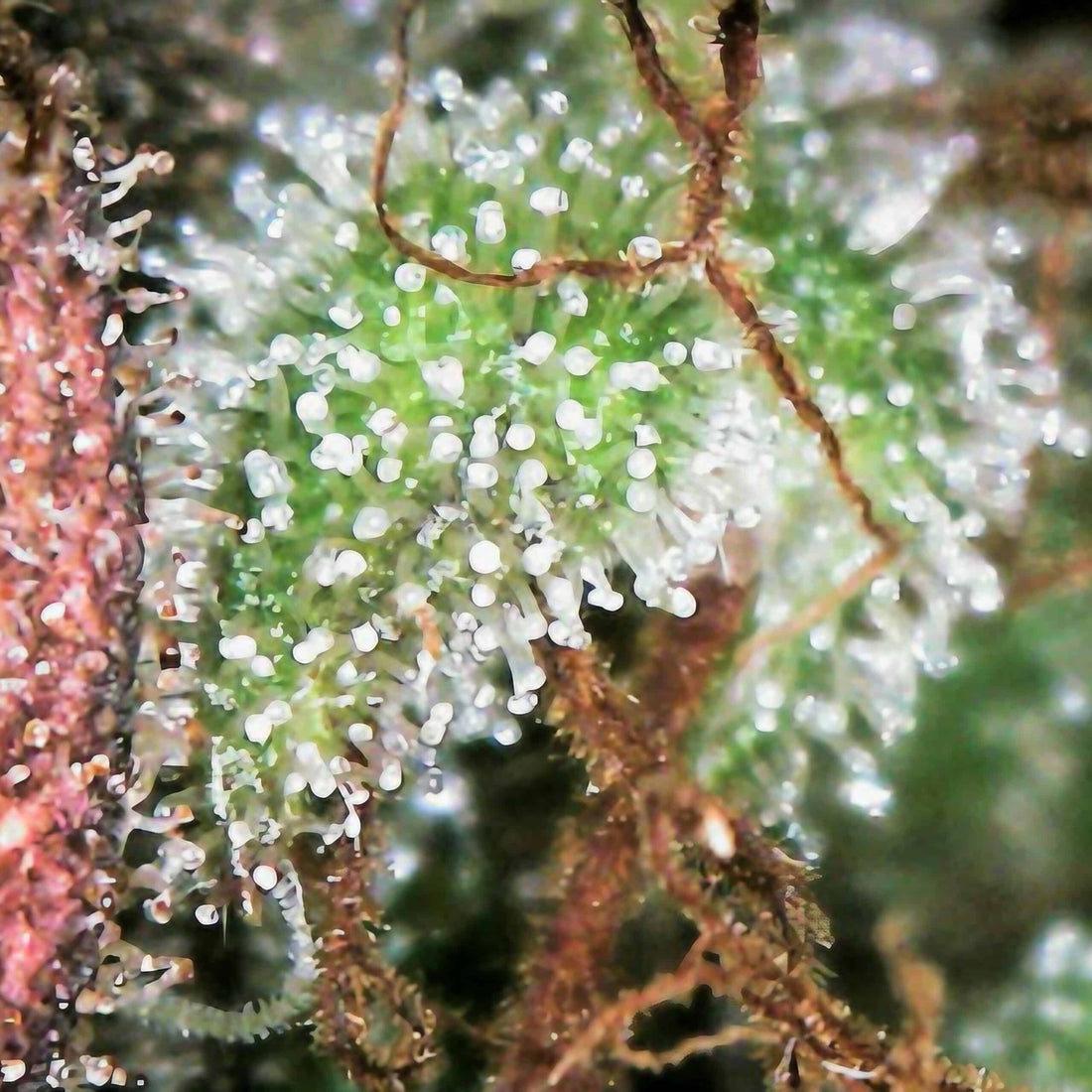The Importance of Trichomes in Cannabis Plants: A Comprehensive Guide
Written by Trevor

Introduction: Understanding the Significance of Trichomes in Cannabis
When examining the anatomy of the cannabis plant, one cannot overlook the importance of trichomes. These tiny, hair-like structures that cover the surface of cannabis plants play a crucial role in their overall function and potency. In this section, we will delve into the definition and function of trichomes, shedding light on why they are highly regarded by cannabis enthusiasts and researchers alike.
Trichomes can be described as glandular outgrowths found on various parts of the cannabis plant, including the leaves, stems, and flowers. They are most commonly recognized as small crystal-like structures that give cannabis buds a frosty appearance. However, their significance extends far beyond aesthetics.
The primary function of trichomes is to produce and store resinous substances within their glandular heads. These resinous secretions contain a variety of compounds known as cannabinoids, terpenes, and flavonoids – all contributing to the unique characteristics and effects associated with different strains of cannabis.
Cannabinoids such as THC (tetrahydrocannabinol) and CBD (cannabidiol) are well-known for their therapeutic properties and psychoactive effects. Terpenes provide distinct aromas and flavors to different cannabis strains while also influencing their potential therapeutic benefits. Flavonoids contribute to both aroma and color variations in cannabis plants.
Understanding trichomes is essential for growers, breeders, researchers, and consumers alike. By studying these microscopic structures’ development and density on cannabis plants, one can gain insights into factors such as potency levels, cannabinoid profiles, flavor profiles, and even potential medicinal applications.
In subsequent sections following this introduction on trichomes in cannabis plants, we will explore further details about their morphology (structure), types (such as bulbous or capitate), stages of development (from clear to cloudy or amber), harvesting techniques for optimal resin extraction – all contributing to a deeper understanding of the intricate world of trichomes and their significance in cannabis cultivation, breeding, and consumption.
The Role of Trichomes in Cannabinoid Production and Potency
Trichomes, the tiny hair-like structures found on the surface of cannabis plants, play a crucial role in the production and potency of cannabinoids. These specialized glands are responsible for synthesizing and storing various compounds, including THC (tetrahydrocannabinol) and CBD (cannabidiol), as well as terpenes.
Cannabinoids, such as THC and CBD, are chemical compounds that interact with our body’s endocannabinoid system, producing various therapeutic effects. Trichomes house these cannabinoids in their resinous secretions, which can be harvested for medicinal or recreational use.
The concentration of cannabinoids within trichomes determines the potency of a cannabis strain. For instance, high levels of THC in trichomes contribute to the psychoactive effects associated with marijuana use. On the other hand, CBD is known for its non-intoxicating properties and is also found in trichomes.
Terpenes are another class of compounds found within trichomes that contribute to the aroma and flavor profile of different cannabis strains. These aromatic molecules not only enhance the sensory experience but also work synergistically with cannabinoids to produce unique therapeutic effects known as the entourage effect.
Understanding the role of trichomes in cannabinoid production and potency is crucial for cultivators, researchers, and consumers alike. By harnessing this knowledge, scientists can develop breeding techniques to cultivate cannabis strains with specific cannabinoid profiles tailored to different medical conditions or desired effects. Additionally, consumers can make informed choices based on their preferences for specific cannabinoids or terpene profiles when selecting cannabis products.
In conclusion, trichomes serve as nature’s chemical factories within cannabis plants. They house valuable compounds such as cannabinoids and terpenes that contribute to both the therapeutic potential and recreational experience associated with marijuana use. The study of trichome biology continues to shed light on how we can optimize cannabinoid production while exploring new possibilities in medical research and cannabis cultivation.
Trichomes as a Defense Mechanism for Cannabis Plants
Trichomes, the small hair-like structures found on the surface of cannabis plants, play a crucial role in their defense mechanism. These trichomes are not just aesthetically pleasing, but they also serve as a natural defense system against various threats.
The structure of trichomes consists of a stalk and a glandular head. It is within these glandular heads that the defense mechanism of cannabis plants resides. The glandular heads contain specialized cells that produce and store chemical compounds such as terpenes and cannabinoids.
These chemical compounds act as insect repellents, deterring pests from feeding on the plant. When an insect comes into contact with the trichomes, it is met with an unpleasant taste or smell due to these compounds. This defense mechanism helps protect the plant from being damaged or destroyed by herbivorous insects.
Furthermore, trichomes also provide physical protection for cannabis plants. The presence of these hair-like structures creates a barrier between the plant’s vulnerable tissues and external threats. They can help reduce water loss through transpiration and provide some degree of protection against environmental stressors like UV radiation.
In conclusion, trichomes serve as an essential defense mechanism for cannabis plants. Their unique structure and insect repellent properties help protect the plant from herbivorous insects while providing physical support and protection against environmental factors.
The Influence of Trichome Development on Harvesting Time and Quality
Trichomes play a crucial role in determining the optimal harvesting time and quality of cannabis plants. These tiny, hair-like structures contain essential compounds such as cannabinoids and terpenes, which contribute to the potency and flavor profile of the final product.
Understanding trichome maturity is key to harvesting cannabis plants at their peak. Trichomes change in appearance as they develop, transitioning from clear to cloudy or amber. The timing of harvest greatly affects the balance between potency and flavor.
Harvesting too early may result in lower levels of cannabinoids, leading to a less potent product. On the other hand, waiting too long may cause an increase in amber trichomes, resulting in a more sedative effect but potentially sacrificing some of the desired flavors.
To achieve the desired balance between potency and flavor profile, growers closely monitor trichome development using magnification tools or digital microscopes. By observing the color and transparency of trichomes, they can determine when it’s time to harvest for optimal results.
Ultimately, understanding how trichome development influences harvesting time allows cultivators to produce cannabis products with specific characteristics tailored to consumer preferences. Striking the right balance between potency and flavor profile ensures a high-quality end product that meets market demands.
How to Enhance Trichome Production in Cannabis Plants
To enhance trichome production in cannabis plants, growers can employ various cultivation techniques. Trichomes are the resinous glands on the surface of cannabis flowers that contain cannabinoids, terpenes, and other compounds responsible for the plant’s potency and aroma.
Genetics play a crucial role in trichome development. Choosing strains known for high trichome production can provide a solid foundation. Varieties such as White Widow, OG Kush, and Girl Scout Cookies are known for their abundant trichomes.
Environmental factors also significantly impact trichome production. Providing optimal conditions such as proper lighting, temperature, humidity levels, and air circulation can encourage robust trichome development. Using full-spectrum LED lights with the right intensity and spectrum can promote resin production.
Nutrient management is another essential aspect to consider. Providing a balanced nutrient regimen during different stages of plant growth helps support healthy trichome development. Phosphorus-rich fertilizers during flowering stages can particularly enhance resin production.
Timing is crucial when it comes to maximizing trichome production. Harvesting at the right moment when the majority of trichomes have reached their peak maturity ensures maximum potency and flavor profiles. Using a magnifying tool like a jeweler’s loupe or a digital microscope to examine trichomes’ color and transparency is recommended to determine the ideal harvest time.
By implementing these cannabis cultivation techniques aimed at enhancing trichome production, growers can optimize their yields while ensuring potent and aromatic buds for consumption or extraction purposes.
Conclusion: Recognizing the Importance of Trichomes
In conclusion, recognizing the importance of trichomes in the cannabis plant is crucial to understanding its anatomy and potential benefits. Trichomes, defined as small hair-like structures found on the surface of the plant, serve a variety of functions that contribute to the overall quality and potency of cannabis.
One key function of trichomes is their role in producing cannabinoids and terpenes, which are responsible for the unique effects and flavors associated with different strains of cannabis. These compounds have been found to have various therapeutic properties, making them highly sought after by medical users.
Additionally, trichomes act as a defense mechanism for the plant, protecting it from pests and environmental stressors. The sticky resin produced by trichomes can deter insects and other predators from feeding on the plant, while also acting as a barrier against harmful ultraviolet (UV) radiation.
Furthermore, trichomes play a crucial role in determining when cannabis plants are ready for harvest. The appearance and maturity of trichomes can indicate the optimal time to harvest for desired effects or potency levels.
Overall, understanding trichome anatomy and function is essential for growers, researchers, and consumers alike. By recognizing their importance in cannabis cultivation and consumption, we can better appreciate the intricate nature of this versatile plant.
Enjoy This Article?
If you enjoyed this article and want to check out our Instagram page for a better look at all products. Also, sign up for our newsletter and follow our Twitter Page for a more posts like this and exclusive deals








